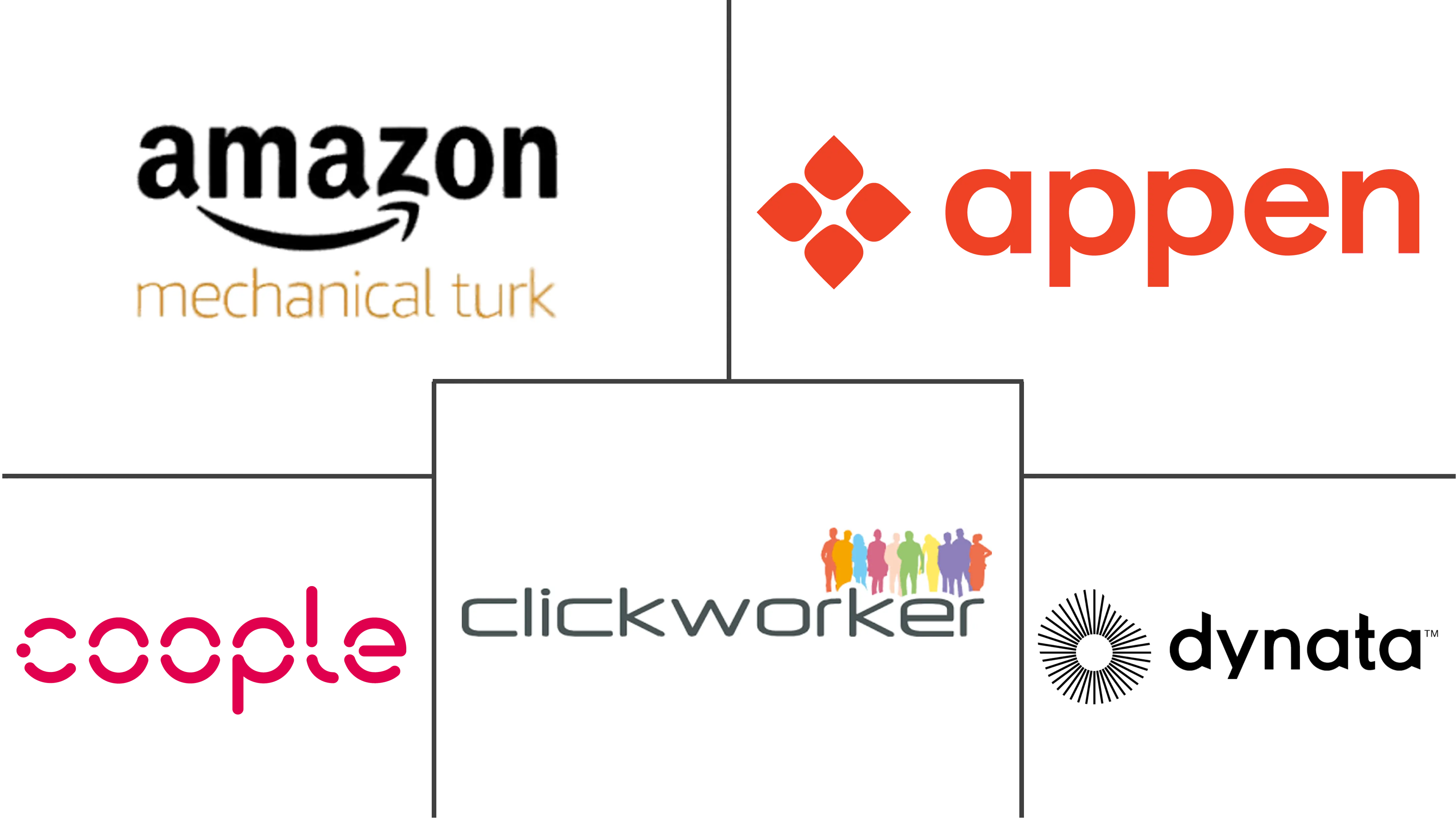Micro-tasking Market Size and Share
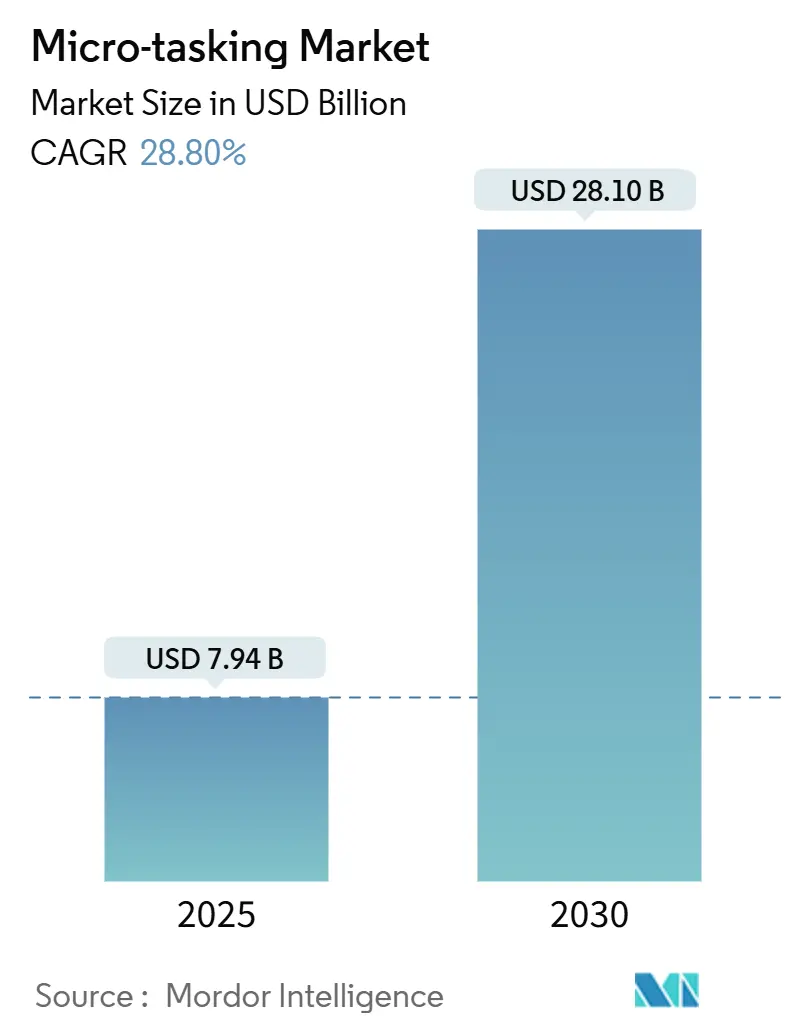
Micro-tasking Market Analysis by Mordor Intelligence
The micro-tasking market is valued at USD 7.9 billion in 2025 and is forecast to reach USD 28.1 billion in 2030, advancing at a 28.8% CAGR. Early momentum stems from the steep rise in AI spending, the proliferation of large-language-model deployments, and a structurally larger remote workforce pool. Enterprises increasingly view human-in-the-loop workflows as a strategic lever to improve model fidelity, while managed service providers consolidate capacity to deliver multi-jurisdiction data governance at scale. Emerging regulatory frameworks now shape vendor selection criteria as much as cost, giving compliance-ready operators a measurable edge. At the same time, hybrid API-first platforms capture new demand from engineering teams that need rapid programmatic access to curated human judgment for continuous model updating.
Key Report Takeaways
- By task type, Data Entry & Processing led with 34% revenue share in 2024, while Image & Video Annotation is projected to expand at a 45.2% CAGR to 2030.
- By application, AI Training & Data-Labeling accounted for 42.5% of the micro-tasking market size in 2024 and is advancing at a 41.0% CAGR through 2030..
- By end-user industry, Technology & Telecom held 28.1% of micro-tasking market share in 2024; Healthcare & Life Sciences is growing fastest at 30.5% CAGR to 2030.
- By geography, North America captured 38.2% revenue in 2024, whereas APAC is expanding at a 27.3% CAGR between 2025-2030.
- By platform model, Managed Service Providers commanded 46% share in 2024; Hybrid/API-first platforms are forecast to grow at 38% CAGR to 2030.
Global Micro-tasking Market Trends and Insights
Drivers Impact Analysis
| Driver | (~) % Impact on CAGR Forecast | Geographic Relevance | Impact Timeline |
|---|---|---|---|
| Expansion of data-labeling for Gen-AI | +8.5% | Global, led by North America & Europe | Medium term (2-4 years) |
| Proliferation of remote & flexible workforces | +6.2% | Global | Short term (≤2 years) |
| Rising digital-commerce SKU audits | +5.3% | North America, Europe, APAC | Medium term (2-4 years) |
| Regulatory pressure for explainable AI | +4.7% | North America, Europe | Long term (≥4 years) |
| Surge in short-form video safety checks | +3.2% | Global | Short term (≤2 years) |
| Adoption of Web3 micro-incentive wallets | +2.6% | Tech-forward markets | Long term (≥4 years) |
| Source: Mordor Intelligence | |||
Expansion of data-labeling for Gen-AI
Labeled data volumes continue to multiply as generative models shift from research pilots to enterprise products. AI teams now commission multimodal preference and ranking tasks that cannot be automated reliably, reinforcing the centrality of the micro-tasking market. Superior training corpora increasingly dictate competitive advantage; operators with vertical-specific ontologies and quality-control pipelines command premium pricing. National AI strategies also highlight annotation capacity as a digital manufacturing asset, prompting policy support in several G-20 economies.
Proliferation of remote & flexible workforces
Permanent adoption of distributed work has unlocked a global talent reservoir, including part-time subject-matter experts who accept high-value annotation gigs around core professional schedules.[1]World Economic Forum, "The Future of Jobs Report 2025", weforum.org Platforms that authenticate credentials and tier compensation accordingly report lower task rejection rates and faster turnaround, moving market dynamics from worker-volume competition to worker-quality differentiation.
Rising digital-commerce SKU counts needing real-time audits
Retailers operating omnichannel pricing now rely on hybrid human-AI loops to flag and correct mismatches across product listings, promotions, and inventory feeds. This workflow generates continuous micro-tasks that demand on-site photographic evidence, stimulating geotargeted task issuance in urban centers.
Regulatory pressure for “explainable AI” datasets
Mandates such as the EU AI Act force enterprises to document decision chains, spawning verification micro-tasks where annotators grade model outputs for fairness and traceability.[2]Federal Register, "Preventing Access to U.S. Sensitive Personal Data", federalregister.govCompliance budgets flow to providers capable of combining secure environments with expert reviewers.
Surge in short-form video safety checks
User-generated video below 30 seconds demands near-instant review cycles to uphold brand safety on social platforms. Annotators tag violence, hate speech, and policy breaches, while AI pre-filters accelerate throughput, sustaining high-volume micro-task streams.
Restraints Impact Analysis
| Restraint | (~) % Impact on CAGR Forecast | Geographic Relevance | Impact Timeline |
|---|---|---|---|
| Privacy & data-sovereignty laws | -5.2% | Europe, India | Medium term (2-4 years) |
| Persistent low pay driving worker churn | -4.1% | Global | Short term (≤2 years) |
| Language quality concerns | -2.8% | Non-English regions | Medium term (2-4 years) |
| Rising carbon-audit costs | -1.9% | Europe, North America | Long term (≥4 years) |
| Source: Mordor Intelligence | |||
Privacy & data-sovereignty laws (GDPR, DPDP-India)
Regional data-protection regimes fragment annotation pipelines, compelling providers to isolate data and labor pools by jurisdiction.[3]Federal Register, "Preventing Access to U.S. Sensitive Personal Data", federalregister.govCompliance redesign raises unit economics and favors managed service operators with federated cloud infrastructure.
Persistent low pay leading to worker churn
Below-minimum pay has intensified scrutiny of platform wage practices, with Human Rights Watch documenting gaps in basic protections.[4]Human Rights Watch, "The Gig Trap: Platform Work in the U.S.", hrw.org High churn jeopardizes output consistency, prompting premium platforms to pilot guaranteed-rate models and skill-ladder programs.
Segment Analysis
By Task Type: Visual Data Fuels AI’s Next Frontier
Data Entry & Processing currently holds the largest market share at 34.0% in 2024, serving as the foundation of the micro-tasking economy through its broad applicability across industries and relatively standardized workflows. Whereas, Image & Video Annotation will generate the fastest revenue growth, expanding at 45.2% CAGR to 2030 as demand soars for spatial labeling in autonomous driving, medical imaging, and retail analytics. Platforms embed ML-assisted annotation to cut per-frame costs, yet human validation remains indispensable for contextually rich bounding and segmentation tasks.
Continued toolchain innovation—auto-suggest, smart-polygon, active learning—raises throughput without eroding task volumes because enterprises now label finer-grained attributes. Content Moderation regulators tighten liability rules for social media. Audio Transcription benefits from rising multilingual voice-assistant roll-outs, while Surveys & Feedback evolves toward emotion-coding assignments, blending quantitative polling with qualitative sentiment capture. The micro-tasking industry thus shows a two-speed profile: commoditized text tasks plateau, whereas multimodal data-centric work accelerates.
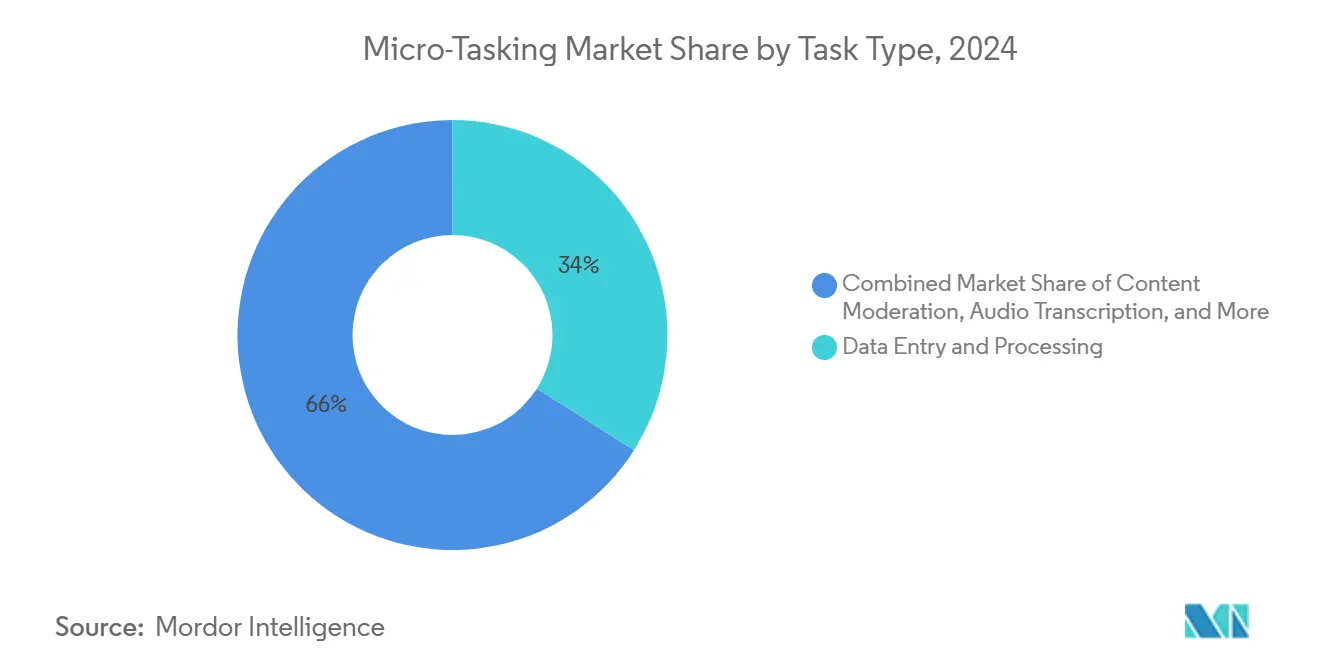
Note: Segment shares of all individual segments available upon report purchase
By Application: AI Training Dominates Growth Trajectory
AI Training & Data-Labeling contributed 42.5% of 2024 revenue and is set to rise at 41.0% CAGR, underscoring its foundational role. Enterprises integrate continuous labeling loops into MLOps pipelines, driving demand for real-time judgment feeds exposed through RESTful APIs.
Trust & Safety/UGC Moderation, responds to regulatory risk and advertiser pressure; automated classifiers execute first-pass screening, yet edge cases still escalate to expert reviewers. Market Research & Insights leverages rapid panel formation for competitive intelligence, while Language & Localization capitalizes on brand pivots toward deeply localized digital experiences. Retail Shelf & Price Audits, though niche, gains strategic relevance as inflationary conditions push retailers to tighten price integrity governance. Collectively these trends reinforce the micro-tasking market as a critical middleware layer between unstructured data and production AI.
By End-user Industry: Healthcare & Life Sciences accelerate specialization
Technology & Telecom captured 28.1% of micro-tasking market share in 2024, yet Healthcare & Life Sciences is poised to outpace every vertical with a 30.5% CAGR through 2030. Hospitals, CROs and medical-device firms now outsource annotation for radiology scans, genomic sequences and clinical-trial notes, activities that require certified talent and HIPAA-grade security controls. NVIDIA’s 2024 launch of sector-specific generative-AI microservices reinforced demand for expert reviewers who can validate model outputs before clinical deployment.
Retail & E-commerce merchants blend automated shelf-recognition with spot-check micro-tasks to maintain price and product data integrity. Government & Public Sector, funds civic-data digitisation and document redaction initiatives, while Education shows a scaling assessment scoring and content localisation. Industries facing stringent regulation or specialised data formats increasingly prefer managed service providers capable of domain-specific ontologies, creating a premium tier within the micro-tasking market. As procurement criteria shift from lowest cost to validated expertise, vertical specialisation is becoming a durable differentiator for platform growth.

Note: Segment shares of all individual segments available upon report purchase
By Platform Business Model: Hybrid/API-first unlocks scalable quality
Managed Service Providers dominated 2024 with a 46.0% revenue share by bundling curated workforces, QA protocols and compliance dashboards into enterprise-grade SLAs. CRN’s 2025 channel survey shows 48% of solution integrators now attach AI consulting to these offerings, turning MSPs into strategic partners rather than simple capacity brokers. Their end-to-end control of data pipelines enables closed-loop quality improvement and jurisdiction-specific data residency—features that resonate with highly regulated customers. However, the approach can limit agility for engineering teams seeking rapid experimentation cycles.
Hybrid/API-first platforms are the fastest-growing model, scaling at 38.0% CAGR to 2030 by exposing human judgement through programmatic endpoints that integrate directly into MLOps workflows. A 2025 arXiv study comparing API and GUI agents highlighted efficiency gains that mirror enterprise preferences for low-code integration and continuous deployment. Open Marketplaces peers as quality variance and rising compliance costs erode price-led advantages. Oracle’s 2024 integration outlook notes the shift toward event-driven architectures; platforms that pair on-demand APIs with managed service layers position themselves to win incremental spend while meeting governance mandates. The competitive frontier therefore centres on combining developer-friendly interfaces with enterprise-class oversight, bridging the gap between speed and assurance in the micro-tasking market.
Geography Analysis
North America commands 38.2% 2024 revenue owing to deep AI capital expenditure—U.S. firms invested USD 109.1 billion in corporate AI projects in 2024.[5]Stanford University, "Artificial Intelligence Index Report 2025", hai.stanford.eduDemand is sustained by enterprise compliance requirements and a skilled freelance base. Growth moderates to 10.2% CAGR as automation of routine labeling expands, yet explainability and regulated-data tasks replenish volume. The micro-tasking market share leadership also reflects a concentration of hyperscale cloud and silicon vendors, whose foundation-model roadmaps depend on continuous human feedback.
APAC delivers the fastest expansion at 27.3% CAGR, propelled by digital-economy FDI surging to USD 230 billion across ASEAN in 2023. China scales multimodal foundation models, India leverages cost-competitive English-proficient labor, and Indonesia offers large mobile-first worker cohorts. Linguistic diversity, however, necessitates advanced quality-assurance frameworks.
Europe holds 21.4% share with 12.4% growth, balancing robust AI uptake against restrictive cross-border data mandates that stimulate in-region micro-task hubs. South America and the Middle East & Africa represent emerging demand pools with respective 19.5% and 24% CAGRs, anchored by youthful demographics adopting gig models for supplemental income.
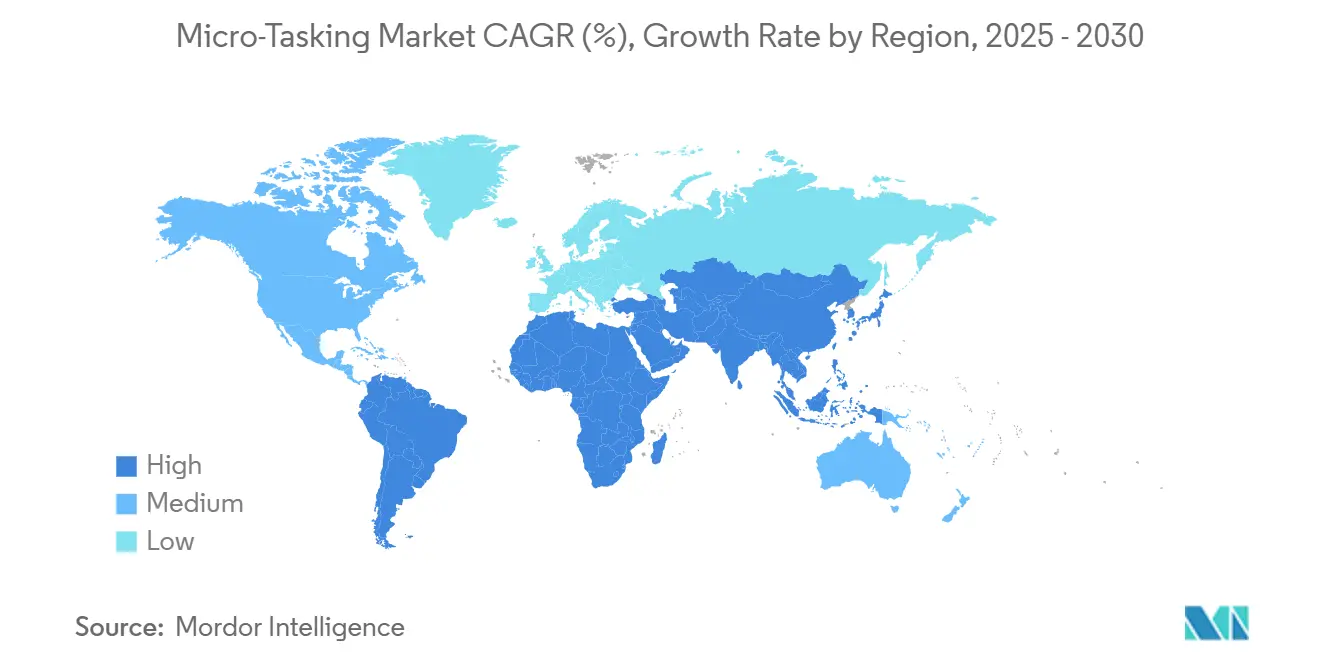
Competitive Landscape
The sector is shifting from a volume-driven marketplace to a quality-led managed service paradigm. Top players integrate annotation tooling, workforce management, and compliance dashboards, enabling enterprise SLAs on accuracy, privacy, and turnaround. LXT’s 2025 acquisition of Clickworker aggregates a six-million-strong talent network, signaling scale-driven consolidation and a move up the value chain into healthcare and autonomous-vehicle datasets.[6]i-Payout, "LXT’s Acquisition of Clickworker" i-payout.comNVIDIA’s verticalized microservices illustrate how technology leaders cultivate specialized task ecosystems to complement proprietary AI stacks, locking in high-margin workflows.
Hybrid/API-first entrants differentiate through developer-centric integration and pay-as-you-go contracts, capturing incremental budgets from MLOps teams. Open marketplaces confront downward fee pressure and rising compliance costs, pushing them toward niche verticalization (e.g., medical imaging, legal discovery).
Strategic alliances emerge between cloud providers and annotation firms to embed labeling directly into data-warehouse environments, tightening vendor lock-in. Overall, bargaining power shifts toward platforms that can evidence worker fairness, carbon-accounting transparency, and geographically partitioned data flows.
Micro-tasking Industry Leaders
-
Amazon Mechanical Turk, Inc.
-
Appen Limited
-
Clickworker GmbH
-
Coople AG
-
Dynata, LLC
- *Disclaimer: Major Players sorted in no particular order
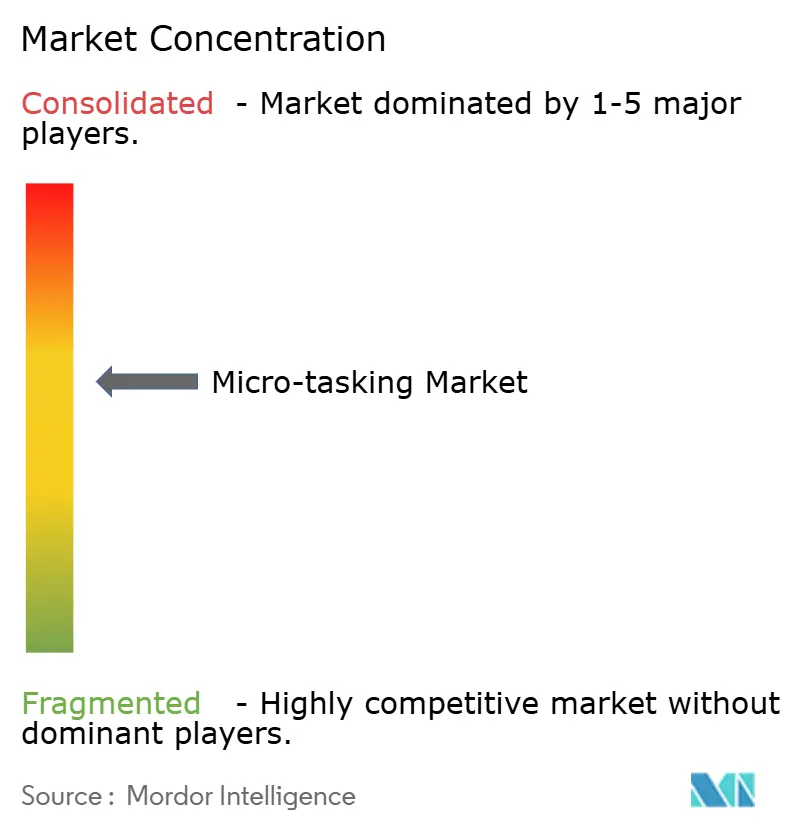
Recent Industry Developments
- May 2025: LXT finalized its acquisition of Clickworker, integrating quality-assured payment rails and expanding sector-specific annotation capabilities, positioning the combined entity to capture regulated-industry contracts.
- April 2025: Labelvisor launched an optimized microtasking platform specifically designed for data annotation, emphasizing the breakdown of annotation jobs to enhance completion speed and quality.
- March 2025: NVIDIA released generative-AI microservices for drug discovery and digital health, generating demand for domain-expert validation tasks and signaling a platform strategy around specialized annotation ecosystems.
- January 2025: The U.S. Department of Justice enacted rules restricting sensitive-data transfers to countries of concern, compelling annotation vendors to re-architect data routing and establish U.S.-only worker pools for affected projects.
Research Methodology Framework and Report Scope
Market Definitions and Key Coverage
Our study defines the micro-tasking market as all online or geo-enabled digital platforms that disaggregate larger projects into very small, independent tasks, typically lasting a few seconds to a few minutes, which remote contributors complete in exchange for per-task payments settled through platform escrow. Activities span data annotation, content moderation, short surveys, search evaluation, and similar "human-in-the-loop" work streams that feed AI models or business process automation.
Scope exclusion: traditional freelance projects that require multi-hour deliverables or in-person gig services are not counted.
Segmentation Overview
- By Task Type
- Content Moderation
- Data Entry and Processing
- Image and Video Annotation
- Surveys and Feedback
- Audio Transcription
- Other Tasks
- By Application
- AI Training and Data-Labeling
- Market Research and Insights
- Trust and Safety / UGC Moderation
- Retail Shelf and Price Audits
- Language and Localization
- Others
- By End-user Industry
- Retail and E-commerce
- Technology and Telecom
- BFSI
- Healthcare and Life Sciences
- Media and Entertainment
- Education
- Government and Public Sector
- Others
- By Platform Business Model
- Open Marketplace
- Managed Service Provider
- Hybrid / API-first
- By Geography
- North America
- United States
- Canada
- Mexico
- South America
- Brazil
- Argentina
- Rest of South America
- Europe
- United Kingdom
- Germany
- France
- Italy
- Spain
- Rest of Europe
- APAC
- China
- Japan
- South Korea
- India
- Australia
- Rest of APAC
- Middle East & Africa
- GCC
- South Africa
- Rest of Middle East & Africa
- North America
Detailed Research Methodology and Data Validation
Primary Research
We interviewed platform executives, workforce managers, and prolific taskers across North America, Europe, and Asia-Pacific, followed by short online surveys with data-labeling service buyers. These exchanges clarified average payment take-rates, task rejection ratios, and adoption barriers, allowing us to challenge desk-based assumptions and finetune regional multipliers.
Desk Research
Mordor analysts first mapped the universe using publicly accessible tier-one sources such as the International Telecommunication Union for broadband and smartphone penetration, the World Bank's digital labor indicators, US Bureau of Labor Statistics contingent-work data, and filings from listed platform operators. Trade associations, including the Mobile Marketing Association and the Global Crowdsourcing Association, provided benchmark pay-rate ranges and worker demographics.
Subscription databases, D&B Hoovers for company revenues and Dow Jones Factiva for deal flow, offered financial and news signals that helped size leading vendors' task volumes. Import-export shipment data from Volza and patent counts in Questel illustrated regional AI-training activity that drives annotation demand. The sources cited above are illustrative; many additional publications were reviewed for data validation and context building.
Market-Sizing & Forecasting
A top-down reconstruction that begins with global digital-labor spending and AI data-labeling budgets is corroborated with one bottom-up supplier roll-up based on declared annual task counts and average service prices. Key variables like smartphone penetration, enterprise AI spending, platform commission rates, regulatory compliance costs, and median task duration feed our multivariate regression model, which generates the 2025-2030 outlook. Forecasts are stress-tested through scenario analysis around data-privacy rules and minimum-wage legislation before final consolidation.
Data Validation & Update Cycle
Outputs pass sequential peer reviews, anomaly checks against independent data points, and senior analyst sign-off. Models refresh every twelve months, with interim revisions triggered by material funding rounds, major M&A, or sudden policy shifts. A fresh validation pass precedes each client delivery, ensuring the view you receive is current.
Why Mordor's Micro-Tasking Market Benchmark Remains the Trusted Reference
Published estimates often diverge because firms choose different task scopes, payment assumptions, and refresh cadences.
Key gap drivers include whether offline gigs are bundled, how unpaid rework is treated, platform fee progression methods, and the currency-conversion year. Mordor Intelligence reports only verified online and location-based micro-tasks, uses live exchange rates, and updates annually, which keeps our baseline grounded in observable realities.
Benchmark comparison
| Market Size | Anonymized source | Primary gap driver |
|---|---|---|
| USD 7.94 B (2025) | Mordor Intelligence | - |
| USD 5.55 B (2025) | Global Consultancy A | Includes only annotation tasks; excludes survey micro-jobs |
| USD 5.13 B (2025) | Industry Association B | Uses 2023 exchange rates and assumes flat commission fees |
| USD 5.13 B (2025) | Regional Consultancy C | Counts offline gig errands yet omits platform take-rates |
These comparisons show how scope choices and assumption rigor shape numbers.
By centering on verifiable task volumes, transparent fee structures, and timely data sweeps, Mordor delivers a balanced, repeatable baseline that decision-makers can rely on.
Key Questions Answered in the Report
How big is the Micro-tasking Market?
The Micro-tasking Market size is expected to reach USD 7.94 billion in 2025 and grow at a CAGR of 28.75% to reach USD 28.10 billion by 2030.
What is the current Micro-tasking Market size?
In 2025, the Micro-tasking Market size is expected to reach USD 7.94 billion.
Who are the key players in Micro-tasking Market?
Amazon Mechanical Turk, Inc., Appen Limited, Clickworker GmbH, Coople AG and Dynata, LLC are the major companies operating in the Micro-tasking Market.
Which is the fastest growing region in Micro-tasking Market?
Asia Pacific is estimated to grow at the highest CAGR over the forecast period (2025-2030).
Which region has the biggest share in Micro-tasking Market?
In 2025, the North America accounts for the largest market share in Micro-tasking Market.
What years does this Micro-tasking Market cover, and what was the market size in 2024?
In 2024, the Micro-tasking Market size was estimated at USD 5.66 billion. The report covers the Micro-tasking Market historical market size for years: 2019, 2020, 2021, 2022, 2023 and 2024. The report also forecasts the Micro-tasking Market size for years: 2025, 2026, 2027, 2028, 2029 and 2030.
Page last updated on:
